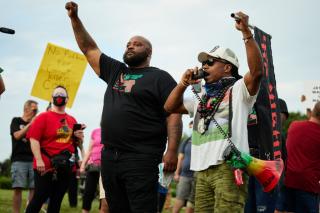Advertisement
As reports emerged from Akron, Ohio, of police shooting Jayland Walker forty-six times as he fled from them on June 27, a friend of mine noted that it seems the reckless killing of Black people by police is nearly a weekly event now.
In reality, it’s far more frequent.
For each event generating a moment of national media attention, dozens more such killings go unnoticed by most people outside the traumatized community. And more than two years after the massive protests that followed George Floyd’s murder, the conviction of any officer for needless killing remains a rarity. Police continue to kill people—especially Black and Indigenous people—at an unconscionable pace and usually do it with impunity.
For Unitarian Universalists, antiracist transformation is central to our work, and transforming our current law enforcement system is imperative.
The modest reforms initiated in some police departments following the public uprising of 2020 have proven woefully inadequate to stop the pervasive killings. This is outrageous. For Unitarian Universalists, antiracist transformation is central to our work, and transforming our current law enforcement system is imperative.
A continuously updated tally launched by the Washington Post in 2015 (inspired by the killing of Michael Brown in St. Louis) shows 1,029 people have been shot and killed by police in the past year. The yearly total has held constant near 1,000 for several years.
The disproportionate killing of Indigenous, Black, and Hispanic Americans, in that order of over-representation, also has remained relentlessly stable.
The Police Violence Epidemic is Nationwide
The media spotlight typically shines only on the most egregious misconduct, which citizens have recorded on video, or when undeniable evidence goes public. But even in an era where citizens routinely document police abuse on video, violent offenders in uniform are rarely prosecuted. And some police deliberately terrorize citizens to prevent them from documenting their violence.
The name Brett Rosenau likely won’t register with many people, but the 15-year-old multiracial boy was killed last week in Albuquerque, New Mexico, because a SWAT team’s “flash bang” grenades ignited the house where Rosenau accompanied a man sought by police. Rosenau was not suspected of any crime, nor was the uninvolved woman who lost her home, dog, and family possessions in the resulting fire.
The Albuquerque police had spotted Qiaunt Kelley—a Black man and the subject of an arrest warrant—in front of the house when he and Brett ran inside. After Kelley declined to surrender unconditionally, the SWAT team launched grenades into the house in the middle of the night, attempting to drive them out. Kelley exited and surrendered, but police apparently made no attempt to save Rosenau as fire engulfed the house and killed him.
The horrific topper to the story? Brett Rosenau never met his father, Brett Sr. A Bernalillo County deputy shot and killed his father in December 2006, months before Brett Jr. was born, according to the Albuquerque Journal. A grand jury declined to prosecute the deputy, who claimed Rosenau Sr. wielded a gun after fleeing a traffic stop, for the killing.
Albuquerque police boast a decades-long history of gratuitous violence, spurring a U.S. Department of Justice investigation.
Such killings are not a rarity in Albuquerque. In fact, its police boast a decades-long history of gratuitous violence, spurring a U.S. Department of Justice investigation. The 2014 DOJ report found police routinely escalated to violence without attempting peaceful resolution of conflicts and “often use deadly force in circumstances where there is no imminent threat.”
Additionally, police supervisors repeatedly concealed misconduct by beat cops and the SWAT team.
National news coverage of police killings typically features major cities on the coasts and Great Lakes region, yet New Mexico police shot and killed seventy-five residents per million from 2015 through mid-2022, easily leading the nation. Alaska, Oklahoma, Colorado, and New Mexico round out the five deadliest states for police killings by gunfire.
Racialized police violence persists nationwide, with deep roots that pervade our entire society. So what can we do?
Campaign Zero is one group focused on solutions—analyzing research and crafting detailed policy recommendations in ten categories to limit police interventions, improve community interactions, and ensure accountability.”
Also, the Unitarian Universalist Association’s Side With Love initiative prioritizes decriminalization and police abolition. The UUA Common Read for 2021–22 is Defund Fear: Safety Without Policing, Prisons, and Punishment by Zach Norris (Beacon Press, 2021). The UUA offers a free discussion/action guide to accompany the book, featuring six lessons with resources and reflection prompts for both group discussion and independent engagement.
These horrific and deadly trends of police violence disregard the humanity of the people they have a duty to protect. And so there will be more victims like Jayland Walker, Brett Rosenau, and all who love them next week—and every week—until we turn moments of outrage into the unrelenting pressure required to uproot a deadly policing system.
